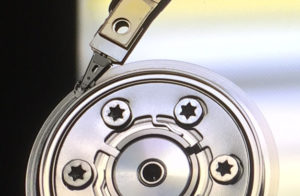Dropbox, one of the world’s leading cloud storage providers, has announced plans to use hard drives featuring heat-assisted magnetic recording (HAMR) in its data centers.
HAMR uses a heating component attached to the hard drive actuator head assembly. By heating the platters with a laser diode, the hard drive is able to bypass the physical areal density limitations of traditional hard drive technology.

The platters and actuator heads of a hard drive.
That’s a fairly technical explanation, and if you’re confused, don’t worry — in another article, we provided a detailed explanation of HAMR technology for laypersons.
The bottom line: By heating platters during the write process, HAMR hard drives can store more data in a small amount of space. They may be able to provide an areal density of 2 terabytes per square inch (2 Tbpsi), which could allow for hard drive capacities of 80 terabytes or more within the next decade.
So, why is Dropbox preparing to adopt HAMR technology — and what will that mean for consumers?
HAMR offers advantages for data centers, but limited utility for personal computer users.
HAMR hard drives will not be cheap, and while they provide incredible capacities, most consumers simply don’t need that much space.
Additionally, all hard drives operate at slower speeds than modern flash media — while HAMR drives offer a lot of space, their read/write speeds are not expected to outperform solid-state media.
For a typical computer user, a solid-state drive (SSD) will offer much faster performance at a much lower price.
But in data centers, the math changes. Dropbox (and every other cloud service provider) uses massive arrays of disks, which work together to store data with multiple layers of redundancy. That means that if a hard drive fails, no data is lost — the data is spread out among all of the storage media in the array.
And because read/write operations are spread out, a RAID (Redundant Array of Independent Disks) can operate much faster than a single SSD.
HAMR hard drives can improve data storage centers in key ways:
- If HAMR hard drives have the same form factor as traditional hard drives, they can slot into current-generation RAIDs.
- By providing much higher levels of data density, HAMR hard drives can extend the value of each array — without taking up more physical space.
- Dropbox estimates that HAMR technology will theoretically allow for servers with capacities of up to 6 petabytes (PB).
To realize these benefits, the cost of HAMR hard drives will need to be similar (on a per-gigabyte basis) to current-generation server hard drives. However, as manufacturers work to perfect the technology, that’s practically inevitable.
Vibration issues may impede adoption of HAMR technology.
There’s (at least) one significant issue that may slow HAMR adoption rates: vibration.
Hard drives are mechanical devices. As the drive’s heads move across the platters, they’re prone to physical disturbances — and excessive vibration may prevent the heads from reading and writing data.
That’s an especially important consideration in data centers. Servers need powerful fans to keep storage media cool, and those fans generate vibrations.
HAMR hard drives have a much higher areal density than conventional hard drives, so their tolerance for vibration is much lower.
To address that issue, Erich Shobe of Dropbox believes servers will need to be designed for the task.
“Our focus in the future will be to minimize HDD performance degradation from system vibrations by suppressing structural vibration of the system chassis and reducing fan noise,” Shobe writes in a blog post.
Dropbox was an early adopter of SMR hard drive technology.
For Dropbox, these challenges aren’t new: The service was one of the first to adopt shingled magnetic recording (SMR), another technology that allows for increased media density.
Shobe notes that HAMR should have equivalent reliability and manufacturability as compared to SMR, but all innovations create novel problems for engineers — and Dropbox is prepared.
“There are amazing advancements happening in the HDD technology space, ranging from nanometer track widths, recording heads flying only about a nanometer above the surface of a disk, platter material advancements, and new recording techniques such as HAMR,” Shobe writes.
“All these advancements provide a path to 100 TB HDDs. As exciting as the last four years with SMR have been, we’re even more excited for the road ahead.
Related: What Is Shingled Magnetic Recording for Hard Drives?
At Datarecovery.com, we’re preparing for HAMR data recovery.
In ideal circumstances, servers have multiple layers of redundancy and extensive backup — but in the real world, disasters can occur.
New hard drive technologies will create challenges for data recovery engineers, and we’re constantly researching new technologies to prepare for those challenges. Our engineers have recovered data from helium hard drives, SMR hard drives, and other server media, and we’re excited for the next generation of storage technology.
To learn about our server data recovery services, submit a case online or call 1-800-237-4200.




